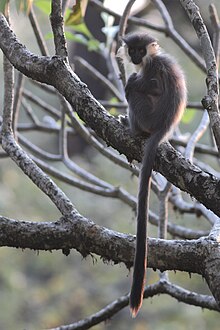
Capped langur

| Capped langur | |
|---|---|

| |
| Capped langur in Manas National Park | |
| Scientific classification | |
| Domain: | Eukaryota |
| Kingdom: | Animalia |
| Phylum: | Chordata |
| Class: | Mammalia |
| Order: | Primates |
| Suborder: | Haplorhini |
| Infraorder: | Simiiformes |
| Family: | Cercopithecidae |
| Genus: | Trachypithecus |
| Species: | T. pileatus[1]
|
| Binomial name | |
| Trachypithecus pileatus[1] (Blyth, 1843)
| |

| |
| Capped langur range | |
The capped langur (Trachypithecus pileatus) is a primate species in the family Cercopithecidae native to subtropical and tropical dry forests in northeast India, Bhutan, Bangladesh and Myanmar. It is arboreal and feeds on 43 plant species.

Taxonomy
The capped langur was described by Edward Blyth in 1843. Four subspecies of the capped langur are recognized as of 2005:[1]

- T. p. pileatus
- T. p. durga
- T. p. brahma
- T. p. tenebricus
Distribution and habitat

The capped langur occurs in northeast India, Bhutan, Bangladesh and Myanmar, where it inhabits subtropical and tropical dry forests.[2]

Behavior and ecology

Capped langurs observed in Arunachal Pradesh spent nearly 40% of the day time feeding on leaves, flowers and fruits. Leaves contributed nearly 60% of the diet, and they foraged on as many as 43 different plant species.[3]

References
- ^ a b Groves, C. P. (2005). "Species Trachypithecus pileatus". In Wilson, D. E.; Reeder, D. M. (eds.). Mammal Species of the World: A Taxonomic and Geographic Reference (3rd ed.). Baltimore: Johns Hopkins University Press. p. 177. ISBN 0-801-88221-4. OCLC 62265494.
- ^ a b c Das, J.; Chetry, D.; Choudhury, A. & Bleisch, W. (2020). "Trachypithecus pileatus". IUCN Red List of Threatened Species. 2020: e.T22041A196580469. doi:10.2305/IUCN.UK.2020-3.RLTS.T22041A196580469.en. Retrieved 17 January 2022.
- ^ Solanki, G.S.; Kumar, A & Sharma, B.K. (2008). "Winter food selection and diet composition of capped langur (Trachypithecus pileatus) in Arunachal Pradesh, India". Tropical Ecology. 49 (2): 157–166.
See what we do next...
OR
By submitting your email or phone number, you're giving mschf permission to send you email and/or recurring marketing texts. Data rates may apply. Text stop to cancel, help for help.
Success: You're subscribed now !

